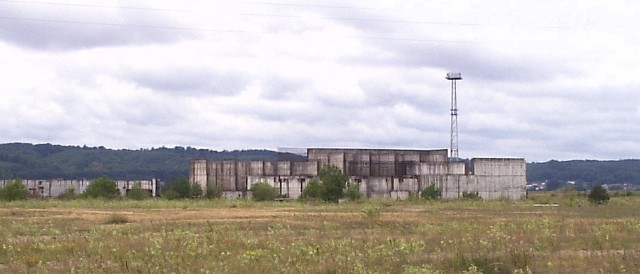Polish authorities find it hard to decide what to do with their current nuclear program, once announced as the great hope for its energy system. No decision at the moment looks like a deliberate strategy although it will not solve the problems of Polish energy supply, as Michał Olszewski explains.

Last time Poland danced with nuclear, it ended in a costly rejection: Ruin of the unfinished Żarnowiec Nuclear Power Plant. (Photo by Jan Jerszyński, CC BY-SA 2.5)
Just six years have passed since the government of Donald Tusk announced that there would be a resolution on the development of nuclear energy. The enthusiasm that accompanied that decision was huge because politicians skillfully argued that the Polish nuclear power plants would be the magic bullet for all the other problems of the Polish energy sector: dependence on coal, the EU’s climate policy, an uneven distribution of power production (the vast majority of Polish power plants are located on the south of the country where heavy industry is developed). The government wanted the north of the country to eventually have two nuclear power plants with a capacity of 3200 MW each. The total costs were estimated at 12 billion Euros. These plans were supported by one more detail: this is the second Polish nuclear program. The first one failed in 1990 when the new post-communist government withdrew from the project, due to pressure from the public, which feared a repeat of Chernobyl. But years have passed, and the social attitude towards nuclear has changed – at the moment nuclear power in Poland does not trigger particularly negative emotions, and the number of supporters of a Polish nuclear program slightly outweight its opponents.
During the past six years, the enthusiasm for this project among politicians has cooled somewhat. The work on this project runs very slowly, as if no one wanted to make a substantial decision. The issue reappears in the national media once every few months, often fueled by an article in a newspaper or TV program.
There are several reasons for this:
- The initial costs have grown rapidly. Some experts believe that the initial amount was significantly underestimated. At this time, the total cost is estimated at approx. 30 billion Euros, and skeptics argue that this amount will be even higher, giving the example of the Finnish nuclear power plant Olkiluoto. Where Poland will get the money from for such a big investment is still unknown. Probably it would be necessary for the government to provide support, which would not be well received by the European Union. And if you take into account only the financial side of this project, it is not profitable. Rising construction costs of nuclear plants and expensive electricity are cooling the initial high hopes for nuclear. According to professor Wladyslaw Mielczarskiego from the Technical University of Lodz, if the plants were to start generating this year, the cost of production of 1 MWh of electricity from coal including the right to emit 1 tonne of CO2 would be about 100 Euros. In the case of a nuclear power plant, it would be 140 Euros.
- It may be that the two 3200 MW nuclear power plants are too big for the Polish energy system to absorbe. However, the construction of a single block of 1200 MW would also be too expensive. In other words, both options would thus bear too great a risk.
- Politicians realize that the price we must pay for the development of nuclear power will limit the development of renewable energy and coal-based energy. While renewable energy sources in Poland are looked upon with great suspicion, the argument of competition for the coal sector must be taken into account. The collapse of even one mine in the south of the country could cause an explosion of social unrest. The country already had a taste of this in January when miners were threatening to go on a much feared general strike due to government plans to close unprofitable mines.
- The price of electricity is currently at historically low levels, which discourages thinking about expensive investments.
- The project has been abandoned by politicians generally. There is currently no significant political figure who would like to take the responsibilty for such a risky nuclear venture.
Recent weeks have brought about an interesting decision: the Polish daily newspaper “Rzeczpospolita” reported that the company PGE EJ1, which is responsible for preparing the construction of the first Polish nuclear power plant, has decided to terminate its contract with the Australian company WorleyParsons, which was hired to conduct environmental studies necessary to obtain permission to build a nuclear power plant. According to the board of PGE EJ1, WorleyParsons did not perform their 60 million Euro worth of liabilities. However, the Australians do not plead guilty and say that the Polish client behaved unprofessionally and was not prepared to invest in the project. Probably both sides will meet in a court. Regardless who is right, it means further delays. One can say that the Polish nuclear program has gone from being an eagerly awaited baby to an unwanted child. And there is no one who wants to say it openly.
Michał Olszewski (born 1977) – journalist, reporter, writer. For more than twelve years he worked for Gazeta Wyborcza and Tygodnik Powszechny, where he concentrated mostly on environmental issues. He is engaged in a Krakow-based campaign against air pollution.